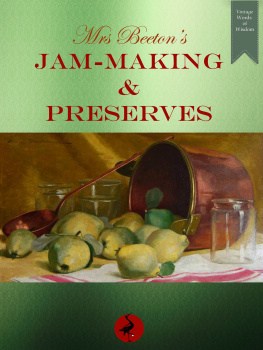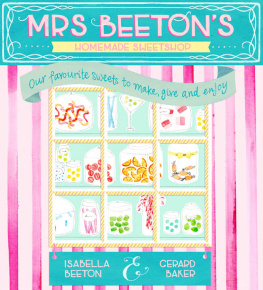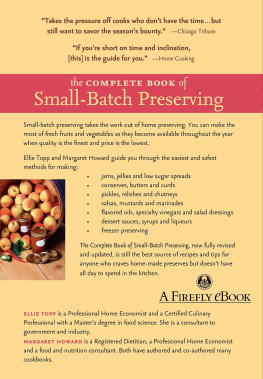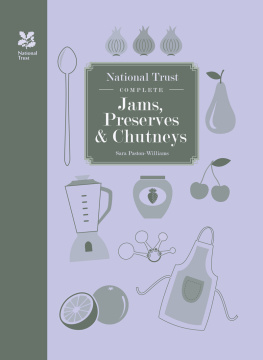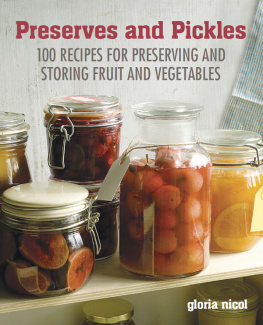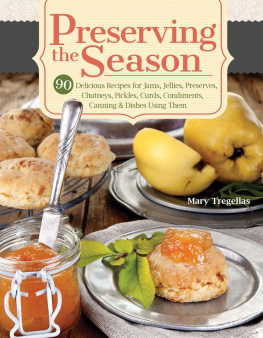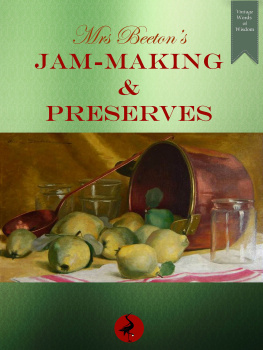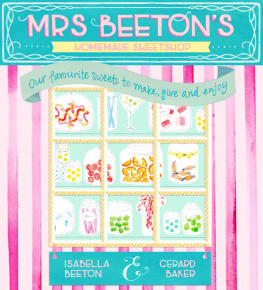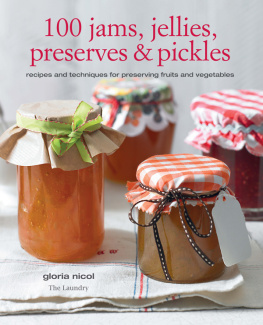PUBLISHERS FOREWORD
This useful recipe book from the 1920s includes 400 recipes for jams, jellies, pickles, chutneys, and wines. It also provides detailed guidance on all aspects of preserving, bottling, sterilising, drying and crystallising fruits. The recipes are based on those by Mrs Beeton (including the now famous carrot jam) and they have been updated to include advances in techniques that were common in the early twentieth century. Familiar recipes are included alongside more exotic preserves like Harvey Sauce, Cucumber Ketchup, Hawthorn Liqueur and Maidenhair Syrup, making this an entertaining and exciting preserving adventure!
Mrs Beetons Jam-making and Preserves provides a fascinating insight into skills and methods that were in use before the invention of the food processor and electric hob, and before the presence of a refrigerator in every home. Among other methods, jars of jam are sealed with paper brushed with the white of an egg and some vegetable preserves are topped with clarified mutton fat to create an air-tight seal, the preparation of some ingredients takes many days, and the quantities of sugar, for example, many surprise the modern jam-maker. However, all these recipes can be adapted to suit modern tastes and to take advantage of modern technology. Though perhaps not for the beginner, this book offers a wealth of preserving challenges for the confident cook. From recipes for ingredients not commonly used today to unusual combinations and preserves that, quite frankly, sound disgusting and/or positively dangerous (have a look at the Mustapha Ketchup recipe try at your own risk!), this collation is an enjoyable exploration of the history of preserving and a rare opportunity to experience the tastes that a previous generation enjoyed.
ADVICE AND SAFETY FIRST
Weights and measures conversions
There are plenty of useful conversion charts available online (see, for example, http://www.deliciousmagazine.co.uk... or, for a more historical guide, see http://gwydir.demon.co.uk...) and in other recipe books so we wont go into a great deal of detail, but here is a brief guide. Ingredients in this book are measured in old British Imperial units:
Ounces (oz) 1 oz. is 25 gms.
Pounds (lb.) 1 lb. is 450 gms.
Saltspoons a saltspoon is a of a teaspoon or 1.2 ml.
Mustardspoons the only reference I can find to this quantity suggests that it is about 200 mg. However, the internet informs me that it is a surprisingly common measurement, used for everything from (obviously) mustard to medicines. Therefore, I can only assume that more people have mustard spoons than I would imagine!
Teaspoons 1 teaspoon is 5 ml. In one recipe it refers to an eighth of a teaspoonful, which is a definitely just a pinch!
Dessertspoons 1 dessertspoonful is 10 ml. or 2 teaspoons.
Tablespoons 1 tablespoon is 15 ml (or 3 teaspoons).
Gill 1 gill is 5 fluid ounces or 1.42 ml. There are 4 gills to the pint. The Imperial gill is 1.2 US gills.
Pints 1 pint is an eighth of a gallon, 20 Imperial fluid ounces or 568 ml. (please note that a US pint is 16 fluid ounces or 473 ml.). The other way round, I remember the conversion of litres to pints as a litre of water is a pint and three-quarters it sticks in my brain this way.
Quarts 1 quart is 2 pints (a quarter of a gallon) or 1.14 litres.
Gallons 1 gallon is 8 pints or 4.55 litres. The US gallon is 3.79 litres.
Glossary
Baysalt this is sea salt (e.g. Maldon sea salt) i.e. salt from the bay.
Capillaire a syrup or infusion of the Maidenhair fern (for more details visit http://www.theoldfoodie.com...).
Capsicum these are sweet peppers.
Clary the flowers of the clary sage plant (for more details visit, for example, http://theherbgardener.blogspot.co.uk...)
Cowslips remember that, while not illegal, it is not advisable to pick great quantities of wild flowers. Cowslips are not as common as they were when this book was written (though I dont think that cowslip wine makers are to blame!) so they should be allowed to flower in peace so that they can disperse their seeds far and wide. It is illegal in the UK to uproot wild flower plants in order to transfer them to your own garden.
Gum arabic also known as acacia gum, this is used today by the food industry as a stabiliser (E414). It is used as an edible glue and binder, an emulsifier and thickening agent. It is available to buy online.
Isinglass made from the dried swim bladders of fish, this is a form of collagen used for the clarification of wine and beer. Drinks made using isinglass are therefore not acceptable to many vegetarians and all vegans, but there are vegan alternatives such as Bentonite and Irish moss.
Racking siphoning off wine from the lees (sediment) into another vessel. There are plenty of websites on wine-making that provide more details.
Radish pods if radish plants are allowed to bolt they produce seed pods. These seed pods are edible they taste like radishes, crunchy and delicious. In Indian cuisine they are known as mogri or moongre.
Equipment
Sugar (candy) thermometer this is a vital piece of equipment for many of the recipes in this book. It should be clean and dry before it is put into a pot of hot syrup or it might make the syrup spit. Hot sugar is flammable and sugar burns are nasty.
Preserving pan this book recommends a copper or brass preserving pan. These are fine if used carefully but the book quite rightly gives a clear warning about not using vinegar in a copper or brass pan and you will notice that it recommends using earthenware vessels to macerate fruit and vegetables. Copper pans react with fruit acid and vinegar to produce toxins. Also, copper pans must be cleaned and dried very carefully or they will develop verdigris a green pigment composed of various toxic copper compounds. For more information visit, for example, http://hitchhikingtoheaven.com... The safest option these days is to use a stainless steel preserving pan. Aluminium is also OK as current research shows that earlier warnings about aluminium and Alzheimers disease were probably exaggerated. However, there are plenty of good quality stainless steel preserving pans available at reasonable prices, and they are much easier to clean than the older copper or brass pans, though they perhaps have less vintage glamour.
A silver knife this book was written before stainless steel was in common use. Old steel knives would become stained after exposure to fruit acids and the knife could also taint the fruit. Silver doesnt react to fruit acids so fruit knives were made of silver or silver-plated. However, remember that stain-less doesnt mean stain-proof so, while stainless steel knives are fine for most fruit and vegetables, if they come into contact with very acidic fruit like lemons then they should be cleaned immediately to avoid staining.
Bottles and jam-jars these days you can buy a wide-variety of glass jars for bottling and for jams, jellies and chutneys. My mother reuses all sorts of glass jars for her jam-making and preserving. As long as they are washed, sterilised and dried properly, and as long as the lids provide an effective air-tight seal, they can be used again and again.
Useful links
One key skill that is required in order to make many of the recipes in this book successfully is the boiling of sugar and the creation of syrups. Here are some useful web links that provide illustrated advice and detailed information on the different degrees of syrup strength.

